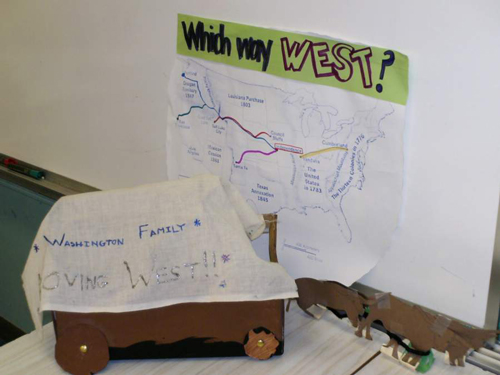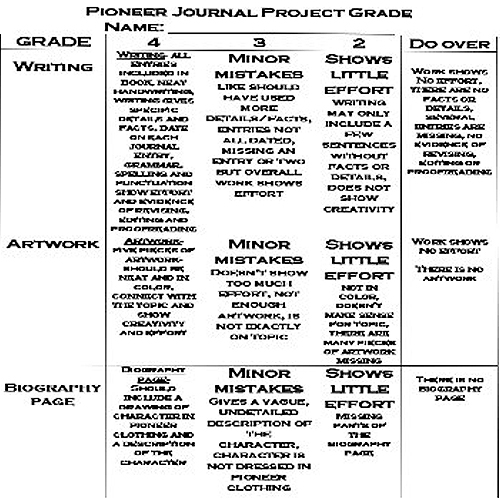In Their Own Words: The Slave Narratives
| Name: |
Dawn Panebianco |
| School: |
PS 124 Yung Wing Elementary School |
| Address: |
40 Division Street |
| City: |
New York , NY, 10002 |
| Original Project: |
In Their Own Words: The Slave Narratives |
| Author: |
|
| URL: |
http://teachersnetwork.org/powertolearn/bryant.htm |
How did you modify this unit for use in your own classroom?: In the original unit, students investigated the slave narratives and gave a human voice to the struggles and hardships the slaves faced in our country's history. I wanted to find a way to bring humanity to the pioneer experience through a simulated experience that combined research and facts with cooperation and understanding. I wanted to show that all history can be studied and understood by revisiting the voices of the past.
List your primary instructional objectives for your students.
| |
For students to use nonfiction books, primary sources, and Internet resources to acquire content knowledge about Westward Expansion in the United States |
| |
To take a simulated trip west as a member of a pioneer family to gain an understanding of the emigrant experience |
| |
To learn and explore features of historical fiction |
| |
To write historical fiction journals of their pioneer experience using the facts and information they have learned about the time period as well as their interactions with their fictional pioneer families |
What role did technology play in this curriculum unit?: Technology was vital to the successful implementation of our unit because it allowed students to access varied information that broadened their understanding of Westward Expansion. Students used primary sources from the Internet including historical journals to learn about the time period and the emigrant experience. Mapquest, www.mapquest.com, was used to calculate the distances between cities so that students could determine how long it would have taken when traveling along trails from different starting points. Several students expanded their vocabularies by searching images of items that the pioneers used that they had never seen or heard of before. Students were able to add details to their wagons based on their Internet research of the specific parts of the wagons and the purposes. Overall, for every interest, their was an Internet site that students could access for information and resources. Web sites used included: http://over-land.com/diaries.html http://oregontrailcenter.org/HistoricalTrails/PioneersTalk.htm http://endoftheoregontrail.org/road2oregon/sa26diaries.html http://easyfunschool.com/article1086.html http://pbs.org/weta/thewest/places/trails_ter/oregon.htm
How did you assess and evaluate student performance?: This unit is a collaborative endeavor as well as an individual project. Students were informally assessed on their ability to perform tasks collaboratively and problem-solve constructively with one another as their family faced obstacles or made decisions on their journey. Individually, students were assessed in reading and writing conferences. Students had many opportunities to read various leveled materials and work at their own pace and ability level while achieving a common goal. At the end of the project, a rubric was developed by the class as a way of evaluating student performance on individual journal books.
Please tell us briefly about your background & teaching experience: This is Ms. Panebianco's seventh year teaching. It is her third year at P.S. 124, Yung Wing Elementary School where she currently teaches 5th grade. Her prior teaching experience includes working with "the little ones" in Pre-K and kindergarten. She used that experience to remind her that learning should always be fun and that older students deserve to play while they learn too!
What are your recommendations for other teachers interested in adapting this unit?: There are so many possibilities for this unit! As I continue to expand on it, I find more and more ways to make it an interdisciplinary unit. There are various opportunities for mathematical problem-solving, learning computer skills, art, cooking, drama, and geography- just to name a few!
Samples of Student Projects
| |
Students researched types of wagons the pioneers used on their trip west and constructed a wagon to meet their family's needs. Detailed parts of the wagon were also added to help the students gain a better understanding of how each part of the wagon was used. |
| |
 |
| |
|
| |
Students researched types of supplies the pioneers needed for their journey west and constructed them to bring along inside their wagon. In most cases, students acquired new vocabulary through investigation. Each pioneer family made a going away quilt for another family to take as a memento of their home and the entire class of pioneers had a "going away" party to wish all of the pioneers well. Before leaving for the journey, the students also devised a budget for the items they would need (given the money they had) and added the weight of their objects to make sure that their wagon would not weigh more than 2500 pounds. |
| |
 |
| |
|
| |
Pioneer families researched the various roles of family members as well as what a typical day would be like for a pioneer family on the trail. They devised a schedule of their daily activities-making sure that each family member and wagon train member was contributing to the cause. |
| |
 |
|